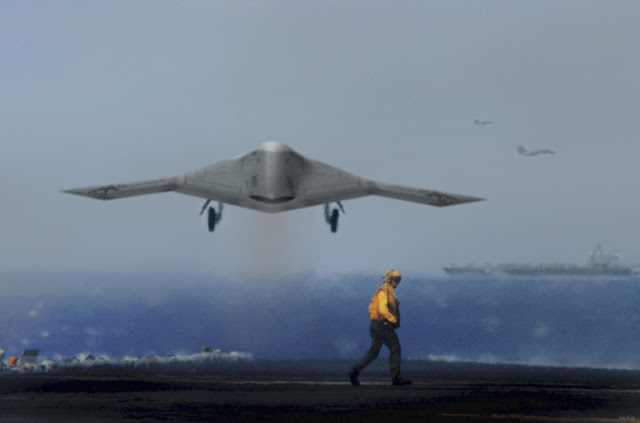Δείτε τα βίντεο από τις δοκιμές και την πρώτη πτήση ενός από τα μη επανδρωμένα μαχητικά του πολύ κοντινού πλέον μέλλοντος...
In August 2007, the U.S. Navy selected Northrop Grumman as the prime contractor for the Unmanned Combat Air System Carrier Demonstration (UCAS-D) program. The program will demonstrate the first-ever carrier launches and recoveries, and autonomous aerial refueling by an autonomous, low-observable representative unmanned aircraft.
The six-year $635.8 million contract calls for the development of two fighter-sized, long- range, high endurance aircraft designated the X-47B. Test activities are in progress that will lead to completion of the Navy's carrier launch and recovery objectives by 2013. Successful at-sea trials will set the stage for potential follow-on acquisition programs.
Δείτε τα βίντεο από τις δοκιμές και την πρώτη πτήση..
Northrop X-47B Assembly And Testing
Northrop Grumman X-47B UCAS-D first flight
Το είδαμε μέσω Pietro Vignoli
Aκολουθούν περισσότερες πληροφορίες και φωτόγραφίες:
Capabilities
The X-47B, a follow up of Joint Unmanned Combat Air Systems (J-UCAS), is being developed as a transformational, carrier-capable, multi-mission, unmanned combat air vehicle.It will perform a variety of missions including Intelligence, Surveillance and Reconnaissance, and Time Sensitive Targeting/Strike.
The low observable strike fighter-sized unmanned fighter will be able to deliver a 4,500 lb (2,045 kg) internal weapon payload to a combat radius of 1,500 nm flying at subsonic speeds at altitudes as as 40,000+ ft.
The X-47B will have a maximum takeoff weight of 45,000 pounds and a max landing weight of around 35,000 - 36,000 pounds, which is similar to Northrop's A-6.
Touchdown speeds are expected to be in the 120-130 knots range, depending on weight and windspeed.
 Autonomous Carrier Landing
Autonomous Carrier Landing
The focus of the program is on demonstrating an ability to land on a carrier, since the navy is evaluating the UCAS-type system as a A-12 replacement possessing the enhanced range and endurance associated with unmanned aircraft..
The UCAS will approach and land autonomously using the Joint Precision Approach and Landing System ship-relative GPS-based landing system. Like other carrier borne aircraft, it will be monitored on its approach by the Landing Signal Officer (LSO), an experienced pilot with responsibility for the visual control of aircraft on short finals. If a UCAS appears to be off the glide path, or the landing area is not clear, the LSO will "wave off" the landing by releasing an interlock switch. This will digitally signal the UCAS to add power and execute a climb straight ahead to 1,200 feet and wait for instructions from approach control, or follow pre-programmed directions.
 Development Progress
Development Progress
The first X-47B, AV-1, was rolled out by Northrop Grumman on December 16, 2008.First flight was initially scheduled for November 11, 2009 with a carrier landing demonstration by November 2011.
Propulsion acoustic issues and problems with engine start sequencing led to delays in the program.
Taxi trials, up to speeds of 120 k took place in December, 2010.
“First flight is just an event, even though it’s an aviation first,” Northrop Grumman UCAS-D Vice President Janis Pamiljans told AW&ST in November 2010.
First flight is planned to last 22-mins with the aircraft flying a racecourse pattern at 4,000 ft. with its landing gear extended. The aircraft will land at the same runway that it takes off from.
First Flight
On Feb. 4, 2011, Northrop Grumman and the U.S. Navy successfully conducted the historic first flight of the X-47B Unmanned Combat Air System Demonstration (UCAS-D) aircraft.
The aircraft flew a racetrack pattern with its landing gear extended, using mild turns. It landed back on the same runway used for take-off.
Περισσότερα: http://knol.google.com/
Περισσότερα: http://knol.google.com/


Δεν υπάρχουν σχόλια:
Δημοσίευση σχολίου
Πείτε το εδώ..!: